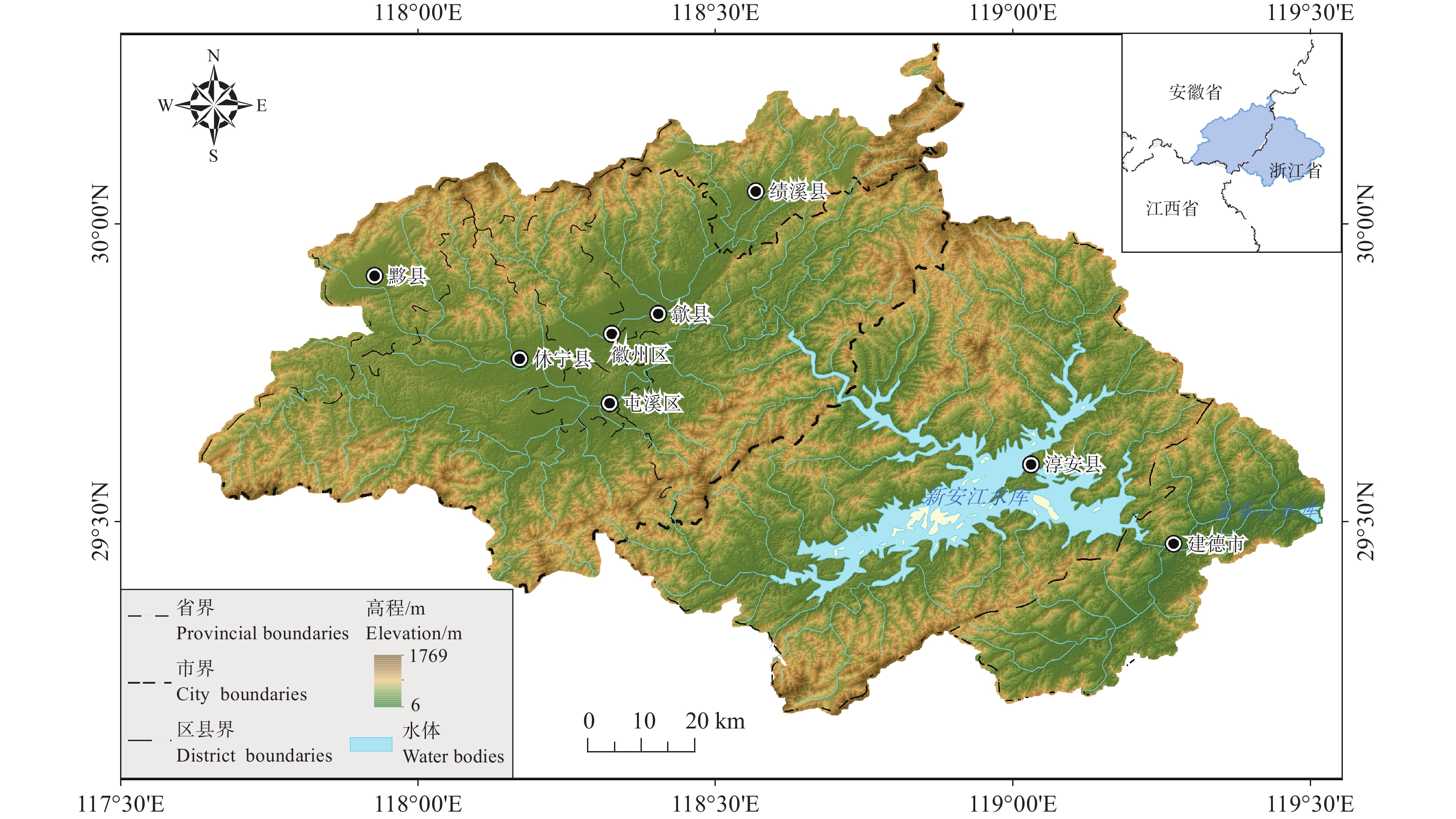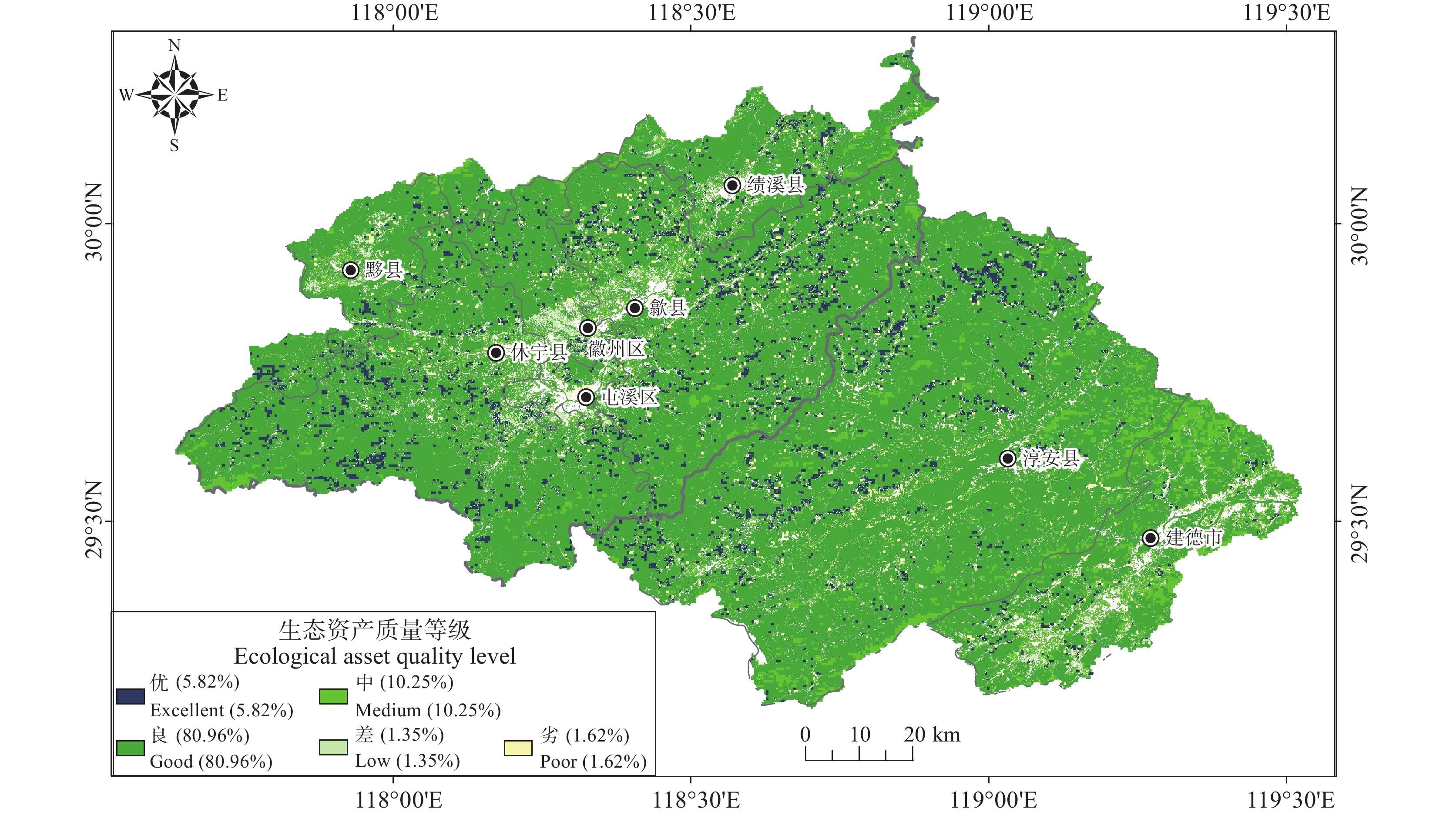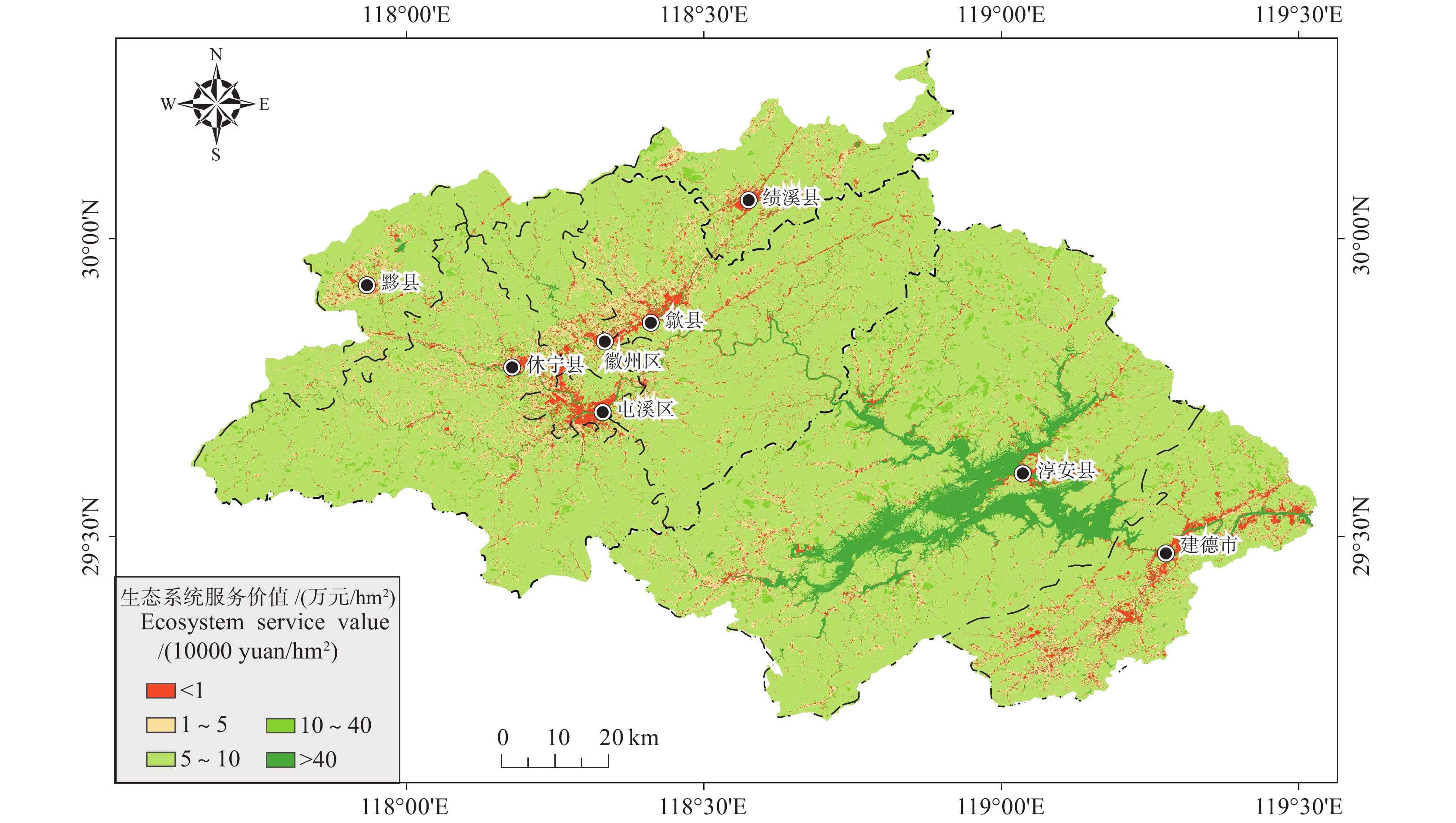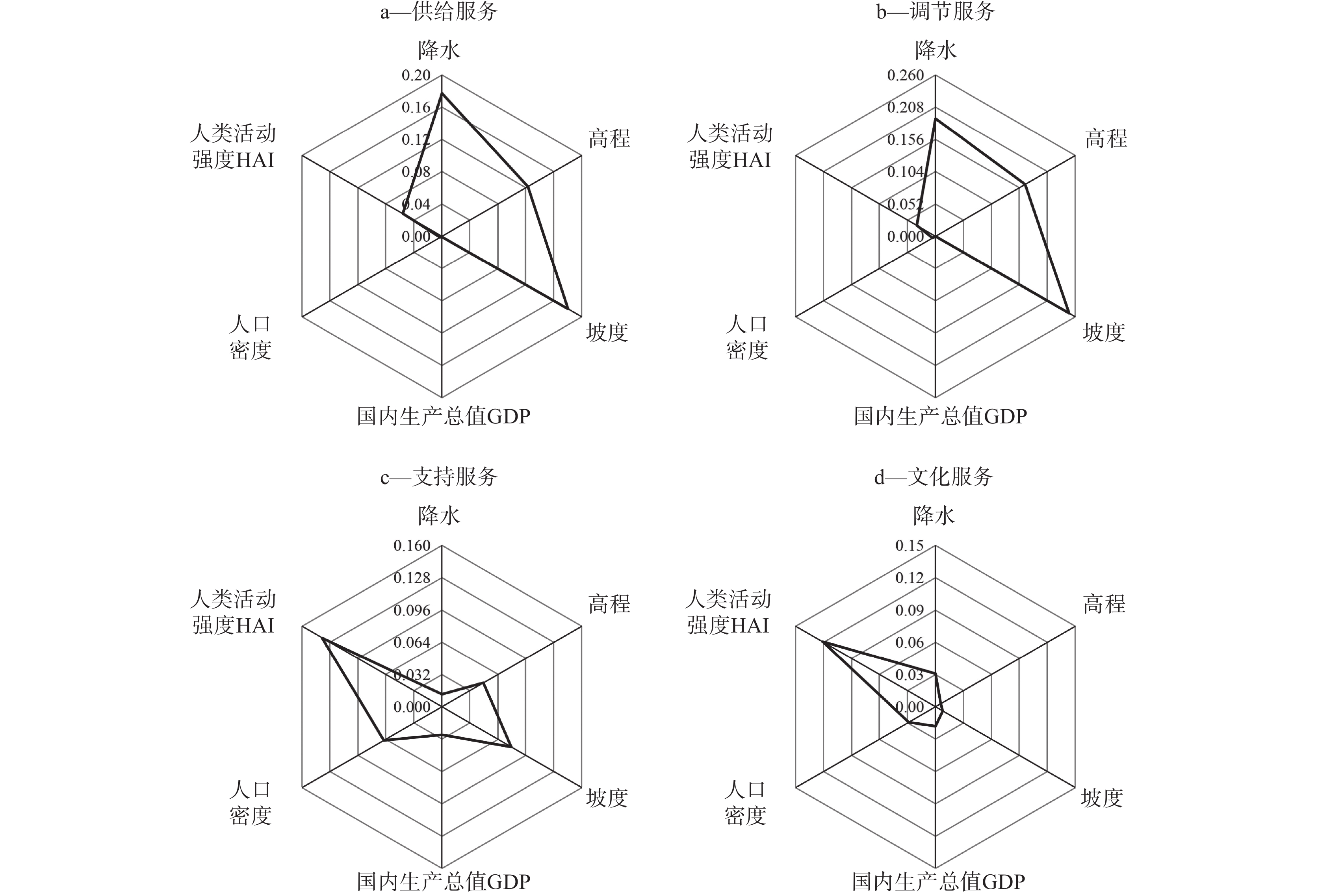Assessment method of watershed ecological asset value in the middle and lower reaches of the Yangtze River: A case study of the Xin'an River Basin
-
摘要:研究目的
生态资产评估有助于理清区域生态资源本底,为建立健全自然资源监管技术体系,实施生态补偿政策提供科学依据,对于推动生态产品价值实现具有重要意义。
研究方法本文构建了生态资产价值评估的方法指标体系,通过集成土地利用、遥感影像、气象、地球化学以及社会经济等多源数据,开展生态资产存量、生态资产质量以及生态资产价值评估,并结合地理探测器探求生态系统服务价值的空间分异影响因素。
研究结果2020年新安江流域生态资产质量等级以良、中为主,分别占比80.96%、10.25%;生态资产存量综合指数为0.77,湿地、森林与园地占主要位置;流域生态系统服务价值为1334.48亿元,森林资源与水资源价值占比最高,坡度、高程和年降水量为影响生态系统服务价值空间分异的主要驱动因子。
结论新安江流域生态资产价值较高,森林与水资源是流域生态系统服务的主要载体,自然禀赋条件对其生态系统服务价值空间分异的影响程度大于社会经济因素。
创新点:集成遥感影像、“土地质量”、“国土三调”、社会经济等多源数据与成果构建流域尺度生态资产质量与价值评估体系,提高评估结果的准确性,可为自然资源核算体系建设提供方法支撑。
Abstract:This paper is the result of environmental geological survey engineering.
ObjectiveThe objective of this research endeavor is to evaluate the ecological asset value, thereby facilitating an enhanced comprehension of the foundational aspects of regional ecological resources. By furnishing a scientific foundation for the establishment of comprehensive natural resource management systems and the effective implementation of ecological compensation policies, this study assumes a pivotal role in promoting the realization of the value of ecological products.
MethodsThis study presented a comprehensive approach for assessing the value of ecological assets. The methodology encompasses the integration of diverse data sources such as land use, remote sensing imagery, meteorology, geochemistry, and socio−economic indicators. Through this integrated framework, evaluations were performed to determine the stock, quality, and value of ecological assets. Furthermore, geographical detector tool was employed to investigate the spatially varying factors that influence the values of ecosystem services.
ResultsThe ecological asset quality in the Xin'an River Basin is primarily in the good and moderate levels, accounting for 80.96% and 10.25%, respectively. The comprehensive index of ecological asset stock in the Xin'an River Basin in 2020 is 0.77. Wetland, forest land, and cultivated land occupy prominent positions. The value of ecosystem service is estimated at 133.448 billion yuan, with forests and water resources having the highest proportion Slope, elevation, and annual precipitation are the main driving factors of spatial differentiation in the value of ecosystem services.
ConclusionsXin'an River Basin has a high ecological asset value. Forests and water resources are the main carriers of ecosystem services in the basin. The impact of natural endowments on the spatial differentiation of ecosystem service values is greater than that of socio−economic factors.
Highlights:The integration of multi−source data including remote sensing images, land quality, land survey, and socio−economic factors was employed to establish a comprehensive assessment system for the ecological asset quality and value at the watershed scale. This approach aims to enhance the accuracy of the assessment results and provide method for construction of natural resource accounting system.
-
1. 引 言
生态地质学是研究生态问题或生态现状地学机理和地质过程的交叉学科,重点研究岩石圈和其他地表圈层相互作用下的生态特征及其形成规律(Trofimov,2013)。地表生态特征(林地、草地、湿地、沙漠等)是特定生态条件下的特征表现,是区域气候、地质条件及其衍生的地貌条件之间耦合作用的结果(Carni et al.,2016)。
岩石风化成土过程是岩石圈和其他地表圈层相互作用的主要形式,其间发生的各种作用不断地改变着地表格局、影响着地表环境,并且为生态系统的可持续发展、地表生命系统的维持和演化提供重要的环境和物质资源(杨骏雄等,2016)。岩石风化成土的过程中释放众多植物生长所需的营养元素,同时微量元素也由于物质的淋溶和淀积在土壤不同层位进行再分配。在山地表生带基岩层、风化层(成土母质)、土壤层、植物物质流动呈现垂向传导继承性规律(李正积,1996)。因此,不同基岩风化形成的土壤对适生植被及品质具有显著影响(简中华等,2013;孙厚云等,2020)。另一方面,由于地形地貌、土地利用类型等差异,导致土壤风化过程中元素迁移过程不尽相同(陈儒章等,2016;张坤等,2018;宋照亮等,2020)。
土壤风蚀是在以风力为主的外营力作用下,土壤颗粒发生的脱离地表、搬运和沉积的动力学过程,是导致中国北方干旱、半干旱地区土壤养分流失、土壤退化、土地荒漠化的主要原因之一(Wang et al.,2009;Yue et al.,2015;李达净等,2018;赵海鹏等,2019)。内蒙古阴山北麓地区南靠阴山山脉、北接蒙古高原,是中国北方受荒漠化威胁最严重的地区之一,也是中国生态最为脆弱的地区之一。它处在华北地区上风向,是京津地区沙尘暴天气的主要沙源地(陈正新和尉恩凤,2002)。该地区海拔相对较高,降雨量少、蒸发量大,气候干旱,风蚀作用是引起该地区土壤不断沙化、生态功能衰退的主要因素(魏洁等,2003;李晓丽等,2006)。该地区由低到高的地貌区主要植被类型分别为草、灌木和乔木,与正常的山地植被垂直分带表现出相反的变化规律。为阐明风蚀作用、土地沙化与植被空间分布之间的关系,本文重点研究阴山北麓不同地貌区基岩风化剖面中元素的迁移过程,分析风蚀作用的影响,土地沙化的原因,诠释生态地质特征与生态系统的耦合关系,以期为干旱、半干旱地区生态系统保护修复提供理论支撑。
2. 研究区概况
研究区位于内蒙古自治区中部阴山北麓固阳县—察哈尔右翼后旗一段。该地区属于中温带半干旱区,年平均气温2.0 ℃,其中1月份气温最低,平均为−15.0 ℃,7月份气温最高,平均为19.0 ℃;年平均降水量为300~400 mm,6—8月份降水最多,占全年的70%;年平均蒸发量为2000~2750 mm,是降水量的8倍以上,冬季蒸发量小,春季蒸发量大。北风、西北风是该地区一年中最主要的风向,年平均风速为3~5 m/s,风季集中在每年11月到来年的5月,其中3—5月风速最强,平均风速为4~6 m/s(吴晓光,2019)。干旱的气候条件和强劲的风力作用对该地区的土壤层造成了强烈的侵蚀,地表重量较小的细粒物质在风蚀作用的影响下飞至高空,以悬移的方式随风运行;颗粒较大的物质则以跃移或滚动的方式沿地表移动。干旱、扬尘、沙尘暴是该地区最常见的自然灾害,主要集中在春季。全年风沙天数平均为7~16天,8级以上的大风天数平均为30~70天,沙尘暴天数为21~26天(周涌和汪德水,1999)。
阴山北麓地势从北向南逐渐升高,地貌类型依次为波状高原、缓坡丘陵、低山丘陵和中山,空间分布基本呈阶梯状(吴晓光,2019)。研究区内,地貌类型分为:武川县—察哈尔右翼中旗地貌类型以中山为主,平均海拔在1800 m左右,植被类型为乔木、低矮灌木和草,植被覆盖度较高;固阳县—武川县地貌类型以低山丘陵为主,平均海拔在1650 m左右,植被类型为草和低矮灌木,植被覆盖度有所降低,局部存在土地沙化;察哈尔右翼中旗—察哈尔右翼后旗地形相对平坦开阔,地貌类型以缓坡丘陵为主,平均海拔在1550 m左右,植被类型以草为主,几乎没有灌木和乔木生长,植被覆盖度较低,存在土地沙化现象(图1)。
3. 样品采集与测试方法
3.1 样品采集
为揭示风蚀作用下不同地貌区基岩剖面的风化特征以及与地表生态的相互关系,在本研究区阴山北麓固阳县—察哈尔右翼后旗一段,低山丘陵、中山、缓坡丘陵3种地貌类型区分别选取5、4、3共计12个具有代表性的岩石风化剖面,剖面点号自西向东分别为D01~D12。其中D01~D05均为花岗岩剖面,位于研究区西部低山丘陵区;D06~D09分别为砂岩、片麻岩、花岗岩和角闪岩剖面,位于研究区中部中山区;D10~D12均为玄武岩剖面,位于研究区东部缓坡丘陵区。具体的采样点位置见图1。
根据基岩的风化程度,将剖面从上向下依次分为土壤层、风化层和基岩层。其中土壤层为剖面顶部,由土壤构成、含少量碎石和植物根系(图2)。为避免外来污染,土壤层样品采自中部,沿同一深度采集3件子样品等重量混合为1件测试样品,去除植物根系、碎石等杂质后至保存于干净塑封袋内并编号,每件测试样品重量不少于1 kg。风化层样品同样采自层中部,根据风化层厚度,沿纵向间隔30~50 cm,采集3~5件子样品,同重量混合为1件测试样品,保存于布制样品袋内并编号。测试样品不过筛,全粒径混合送样。岩石样品采自剖面底部,在同一层位选择风化程度较低的露头,用地质锤敲打出新鲜面,采集2~3块基岩样品组合为1件测试样品,保存于布制样品袋内并编号。
3.2 样品测试方法
3.2.1 XRF测试
常量元素SiO2、Al2O3、FeOT、MgO、CaO、Na2O、K2O用XRF进行测试。主要步骤如下:将样品研磨至200目以下,将其充分混合均匀,并用电子称称取4.00 g混匀的样品放入塑料环中,将少量硼酸放入塑料环外缘,将盛有样品和硼酸的塑料环置于压力机上,升压至制片压力40 MPa,保持压力5 s,减小压力并将其取出,样品被压成直径4 cm的小圆片,然后采用X射线荧光光谱仪进行测试。测试结果用SuperQ 5.0进行分析。
3.2.2 ICP−MS测试
微量元素用电感耦合等离子体质谱法测定:取少量74 μm以下粒径的样品,放置在105 ℃的干燥箱中干燥2 h,然后将样品放入磨口玻璃瓶中待用。用电子称精确称取0.1000 g干燥过的样品放入50 mL的烧杯中,加少量蒸馏水将其润湿,并加入HNO3和HF各10 mL以及2 mL HClO4,使其充分混合,将其放在250 ℃的电热板加热蒸发,从HClO4冒白烟开始计时3 min,时间到后取下烧杯待其冷却,再次加入HNO3和HF各10 mL以及2 mL HClO4,再次置于250℃的加热板上加热约10 min,时间到后关闭电源,使其静置一夜,第二天再次打开电热板电源,加热至HClO4不冒烟,此时将烧杯取下,并加入王水8 mL,继续用加热板加热烧杯,直到溶液体积蒸发至2~3 mL,使用10 mL蒸馏水冲洗烧杯内壁,使其无样品残留,并微微加热烧杯5~10 min,取下烧杯,待溶液冷却后放入带10 mL刻度的试管中,用蒸馏水稀释溶液使其到达试管刻度处,将其摇晃均匀,并静置,取1.00 mL上层清液于试管中,并加入9 mL浓度为3% 的HNO3溶液,摇晃均匀,用电感耦合等离子体质谱仪测定相应元素。
3.2.3 粒度测试
样品粒度由Mastersizer 2000激光粒度仪测定。测试前处理如下:将样品中的有机质和碳酸盐去除干净,使样品颗粒充分分散,形成单颗粒。具体操作步骤如下:取约0.5 g烘干的土壤样品于250 mL烧杯中,用蒸馏水浸泡约10 min;加入10 mL浓度为30%的H2O2来去除样品中的有机质,待其充分反应完全后,置于电热板上加热,去除过量的H2O2;然后加入10 mL浓度为10%的HCl,在电热板上加热至沸腾15 min,直到样品不再反应,从而去除样品中的碳酸盐;在烧杯中加蒸馏水至最上部刻度线,并静置超过24 h,取少量静置样品的上层清液于烧杯中,并加入10 mL的分散剂,用超声波振荡仪振荡15 min后进行测试。仪器配套的进样器为Hydro 2000MU(A),粒径测试范围为0.020~2000.000 μm。
样品分析依照,《土地质量地球化学评价规范》(DZ/T 0295201)进行,按规范要求加10% 空白样与平行样控制,分析方法准确度和精密度采用国家一级标准物质(GBW 系列)控制,各指标的加标回收率均在国家标准参比物质的允许范围内。
4. 分析结果
4.1 常量元素的分布特征
表1为阴山北麓岩石风化剖面中常量元素含量和化学蚀变指数,对比各地区岩石风化剖面中常量元素的变化,可以看出:
表 1 阴山北麓岩石风化剖面中常量元素含量及化学蚀变指数(%)Table 1. Major element content and chemical alteration index in rock weathering profile in the northern piedmont of Yin Mountain (%)地貌区 点号 岩性 层位 SiO2 Al2O3 Fe2O3 MgO CaO Na2O K2O CIA 低山丘陵 D01 花岗岩 土壤层 60.01 10.96 5.13 2.23 4.65 2.20 2.16 53.34 风化层 55.64 11.00 4.41 1.92 8.37 2.24 2.58 51.97 基岩层 67.56 13.59 2.12 0.74 0.61 3.46 5.95 50.66 D02 花岗岩 土壤层 61.12 11.54 4.30 1.78 3.27 2.25 2.48 53.37 风化层 62.04 12.50 2.43 0.88 6.07 2.74 3.78 48.84 基岩层 70.43 13.18 1.50 0.75 1.58 3.90 4.00 49.19 D03 花岗岩 土壤层 60.26 13.16 4.36 2.69 2.86 3.38 3.07 48.31 风化层 69.92 10.04 3.99 3.41 4.62 2.72 5.16 40.86 基岩层 67.28 14.40 1.58 0.33 0.73 5.14 5.47 47.83 D04 花岗岩 土壤层 57.36 13.10 5.62 2.17 2.60 2.25 2.13 57.45 风化层 58.87 14.72 4.46 1.93 3.89 3.78 1.88 50.44 基岩层 64.27 15.01 2.87 1.62 2.87 4.95 2.11 48.98 D05 花岗岩 土壤层 59.86 13.35 4.98 1.84 2.09 2.62 2.63 54.92 风化层 55.25 14.13 7.27 2.03 2.96 3.77 3.07 48.66 基岩层 63.50 13.67 3.82 1.72 3.00 4.25 4.04 44.83 中山 D06 砂岩 土壤层 60.83 12.80 5.50 2.34 1.71 2.70 2.41 55.76 风化层 55.83 12.89 6.31 2.79 1.72 3.12 2.17 54.82 基岩层 50.88 11.16 3.69 2.42 11.82 3.43 1.71 45.92 D07 片麻岩 土壤层 57.36 13.47 6.73 2.57 1.73 1.47 2.61 63.71 风化层 47.87 9.36 3.66 6.10 2.58 0.21 6.62 54.36 基岩层 63.37 14.30 4.00 2.15 1.67 4.69 2.95 50.65 D08 花岗岩 土壤层 60.89 13.30 5.49 2.16 1.51 1.97 2.50 60.49 风化层 63.80 13.88 5.02 1.84 1.91 3.41 2.47 54.14 基岩层 72.99 13.35 1.57 0.77 1.51 3.57 4.89 48.99 D09 角闪岩 土壤层 58.24 13.56 6.67 2.25 2.38 2.53 2.68 54.68 风化层 56.27 14.48 7.00 2.23 2.24 2.71 2.66 55.93 基岩层 54.14 12.61 9.35 2.89 5.54 3.80 1.23 47.70 缓坡丘陵 D10 玄武岩 土壤层 49.15 14.69 9.05 2.94 5.39 1.95 1.70 64.00 风化层 47.99 15.59 9.43 3.07 6.75 1.78 1.55 67.43 基岩层 43.15 14.91 9.98 3.21 13.62 2.26 1.14 63.22 D11 玄武岩 土壤层 57.02 12.31 5.96 2.34 4.54 2.18 2.40 55.78 风化层 45.63 15.09 10.53 2.64 8.80 2.14 2.09 61.90 基岩层 47.41 14.09 9.99 4.07 9.50 3.51 2.25 50.21 D12 玄武岩 土壤层 56.38 13.00 7.23 2.66 3.55 2.20 1.97 58.13 风化层 43.91 12.96 9.11 3.24 11.38 1.86 1.39 62.99 基岩层 49.11 14.91 9.64 3.82 8.94 3.65 1.46 52.33 (1)低山丘陵区岩石风化剖面中,SiO2的含量较母岩均有不同程度的减少,说明该地区岩石风化剖面经历了一定程度的风化脱硅作用(Kanhaiya et al.,2018),个别剖面土壤层中SiO2的含量高于风化层,说明这些剖面土壤层中有Si元素迁入,这可能与风蚀作用的沉降过程有关;Al2O3的含量在剖面中从基岩层到土壤层基本表现为不断减少的趋势,与南方地区岩石风化过程中Al元素不断富集(黄成敏和龚子同,2002)的理论相悖,说明该地区Al元素在风化过程中流失,这可能与风蚀作用的侵蚀过程有关;剖面Fe2O3的含量则不断增加,表现出与Al2O3截然不同的变化规律,说明Fe2O3的稳定性更高,受外界影响的程度较小;花岗岩中Mg、Ca元素的含量较少,因此能够在风化过程中表现出一定程度的富集现象,而且受淋滤作用的影响在个别剖面风化层中进一步富集;花岗岩中含量较高的Na、K元素则在风化过程中表现为不断减少的趋势。
(2)中山区岩石风化剖面中,受母岩岩性影响,相同元素在不同剖面中的行为有所差异,但整体变化趋势基本一致:SiO2的含量相较于母岩以正常风化减少为主;Al2O3和Fe2O3的含量则以增加为主;MgO、CaO、Na2O、K2O的含量表现为不同程度的减少。常量元素在风化过程均表现出基本正常的地球化学行为,说明该地区可能受风蚀作用的影响较小。
(3)缓坡丘陵区岩石风化剖面土壤层中SiO2的含量相较于母岩显著增加,说明该地区Si元素的迁入量更大;Al2O3的含量相较于母岩明显减少,说明该地区Al元素的迁出量较大;土壤层中Fe2O3的含量同样表现出明显减少,说明稳定性较高的Fe元素也表现出一定程度的迁出。这些元素的显著异常变化可能与该地区土壤层经历了比较强烈的风蚀作用有关。MgO、CaO、Na2O和K2O的含量在风化过程中均表现出一定程度的减少,玄武岩中Mg、Ca元素的含量更高,减少的趋势也更明显。
化学蚀变指数(CIA=[Al2O3/(Al2O3+K2O+Na2O+CaO*)]×100%)是判断化学风化程度的重要指标(Nesbitt and Young,1982),在岩石风化研究中应用广泛。式中CaO*是指硅酸盐中CaO的含量,即需要去除碳酸盐和磷酸盐中的CaO。从土壤和沉积物中准确分离和提纯硅酸盐矿物难度较大,因此采用McLennan提出的方法对CaO的含量进行校正(McLennan,1993):若土壤或沉积物样品中CaO的摩尔数小于Na2O的摩尔数,则CaO*=CaO;若土壤或沉积物样品中CaO的摩尔数大于Na2O的摩尔数,则CaO*=Na2O。
一般来说,CIA值介于50~65,反映寒冷干燥气候条件下低等的化学风化程度;CIA值介于65~85之间,反映温暖、湿润条件下中等的化学风化程度;CIA值介于85~100反映气候环境的炎热、潮湿条件下强风化程度(Fedo et al.,1995;Yan et al.,2010)。由表1可以看出,12个剖面中,除D10剖面风化层样品的CIA值超过了65,达到67.43外,其他剖面样品的CIA值均低于65,部分剖面的CIA值甚至低于50,反映了研究区岩石风化剖面整体处于低等的化学风化程度。另外,低山丘陵区和中山区岩石风化剖面由下到上,CIA值不断增大,符合前人所得出的越靠近剖面顶部,岩石风化程度越深,CIA值越大的风化规律(李徐生等,2007);而缓坡丘陵区岩石风化剖面中,基岩层到风化层CIA值增大,但土壤层中CIA值却表现为显著的减小趋势,CIA最大值出现在风化层,这可能与该地区土壤层受到了比较强烈的风蚀作用有关。
4.2 微量元素的分布特征
风化过程中,无论元素富集或是亏损,相同剖面内部不同分层中稳定微量元素的行为总能保持相同的变化趋势,使得微量元素在不同层位间表现出良好的继承性(陶澍等,2001)。然而,外来风化产物的迁入会改变微量元素本身的变化趋势,打破不同层位元素之间的继承性(陈兴仁和周俊,2012)。因此,可以通过剖面土壤层和风化层中稳定微量元素与基岩层的继承性和差异性来判断剖面土壤层和风化层中是否有外来物质的迁入。
为了更好地比较岩石风化剖面中微量元素的含量,需要将微量元素的含量进行标准化处理。上陆壳(UCC)元素丰度是地壳各种岩石各元素含量的加权平均值,与土壤、母岩、地表水、生物等地表圈层各要素的元素丰度关系极为密切(刘文景等,2010)。以样品中各微量元素的含量与上陆壳相对应的各微量元素的含量相比,即得到微量元素的上陆壳标准化值。
使用大陆上地壳元素丰度值(UCC)(Rudnick and Fountain,1995)进行标准化,消除量级差后的结果见图3。可以看出:低山丘陵区岩石风化剖面(D01~D05)中,土壤层对风化层有着良好的继承性,但两者相对于基岩层的继承性较差,说明在风化过程中,外界环境对土壤层和风化层有较显著的影响,明显存在外来物质迁入;中山区岩石风化剖面(D06~D09)中,除D06剖面外,其他3个剖面土壤层和风化层对基岩层的继承性均较差,明显存在外来物质迁入;缓坡丘陵区岩石风化剖面(D10~D12)相较于其他地区岩石剖面来说,各层位之间的继承性最好,但土壤层中微量元素与另外两层略有差异,存在少量外来物质的迁入。研究区岩石风化剖面中外来物质的迁入,可能与风蚀作用的沉降过程有关,风蚀作用的强度越大,外来物质的迁入量越小。
4.3 土壤粒度的分布特征
岩石风化剖面的土壤层是受风蚀作用影响最直接、也是最显著的一层(Xiao et al.,2021)。不同强度的风蚀作用所影响的土壤粒度范围也不同(张腾飞,2020),这使得风蚀作用会对土壤粒度进行一定程度的分选(Chepil,1953)。因此,土壤层中土壤粒度的分布特征是对风蚀作用强度最直观的反映。
12个岩石风化剖面土壤层的粒度分布见表2。可以看出:研究区土壤层中,粉粒(0.002~0.05 mm)的含量最高,占总量的50%~70%;其次为极细砂(0.05~0.1 mm),占总量的15%~35%;然后为细砂(0.1~0.25 mm)和黏粒(<0.002 mm),分别占总量的10%和5%左右;0.25 mm以上的粗粒物质含量最少,仅在个别剖面土壤层中有分布。低山丘陵区岩石风化剖面土壤层中,粒径小于0.05 mm的黏粒和粉粒含量比其他地区略少、极细砂含量较高,可能是风蚀作用对该地区土壤层中的黏粒和粉粒产生了一定程度的侵蚀,并带来了少量的极细砂;中山区岩石剖面土壤层中粉粒的含量较高,可能是风蚀作用带来了外来粉粒物质的沉降,风蚀作用更弱,沉降物质更细;缓坡丘陵区玄武岩剖面土壤层中黏粒的含量略高于其他地区,可能是由玄武岩自身的岩性因素引起的。
表 2 阴山北麓岩石风化剖面表层土壤粒度统计(%)Table 2. Surface soil grain size statistics of rock weathering profile in the northern piedmont of Yinshan Mountain (%)地貌区 粒度名称 黏粒 粉粒 极细砂 细砂 中砂 粗砂 极粗砂 粒径/mm <0.002 0.002~0.05 0.05~0.1 0.1~0.25 0.25~0.5 0.5~1 1~2 低山丘陵 D01花岗岩 4.45 48.39 34.54 12.62 0.00 0.00 0.00 D02花岗岩 4.52 47.59 32.80 11.80 2.16 1.13 0.00 D03花岗岩 3.93 62.20 17.80 8.97 6.00 1.10 0.00 D04花岗岩 3.66 71.67 19.98 3.39 1.29 0.01 0.00 D05花岗岩 5.27 58.45 20.78 6.81 2.93 5.33 0.43 中山 D06砂岩 5.13 60.54 13.96 9.99 8.21 2.17 0.00 D07片麻岩 4.11 64.69 18.42 5.72 3.58 3.12 0.36 D08花岗岩 6.97 70.96 18.17 3.90 0.00 0.00 0.00 D09角闪岩 4.39 64.51 16.30 6.43 5.56 2.78 0.03 缓坡丘陵 D10玄武岩 5.70 68.57 18.75 6.40 0.58 0.00 0.00 D11玄武岩 5.67 62.39 16.38 12.14 3.42 0.00 0.00 D12玄武岩 4.82 63.32 16.87 7.40 6.85 0.74 0.00 5. 讨 论
5.1 风蚀作用的影响
岩石风化成土是原岩矿物不断风化,次生黏土矿物不断形成的过程(黄成敏和龚子同,2000),正常的风化过程会使土壤中黏土矿物含量逐渐积累。但是,当土壤受到外力侵蚀时,土壤中的黏土矿物会在外力作用的影响下迁出,而呈现出减少的特征(刘争光,2021)。其中,水力侵蚀和风力侵蚀是引起土壤侵蚀最主要的两个因素(唐克丽,2004)。水力侵蚀通常表现为河流对其流经区域土壤的侵蚀(穆兴民等,2016),以及降雨产生的坡面径流对山坡表层土壤的冲刷(陈儒章等,2016);风力侵蚀则主要发生在干旱多风、地势平坦、植被稀疏的荒漠、戈壁等地区(张春来等,2018)。
风蚀作用不仅仅会引起土壤层中黏土矿物等细粒风化产物的丢失,还会造成外来物质的迁入(闫玉春,2008)。通过对岩石风化剖面微量元素上地壳标准化蛛网图(图3)的分析可以发现,低山丘陵区和中山区岩石风化剖面中土壤层和风化层相对于基岩层的继承性较差,明显存在外来物质迁入。强度一定的风蚀作用会对土壤中固定大小的颗粒进行侵蚀,风蚀作用强度的增大会带走土壤中颗粒更粗的物质(张加琼等,2018),两者均不会引起外来物质的迁入,只有风蚀作用强度下降、风的承载能力降低时,风中所携带的物质才会沉降。因此认为低山丘陵区和中山区的风蚀作用强度有所减弱。缓坡丘陵区岩石风化剖面各层位间的继承性很好,基本不存在外来物质迁入,只有土壤层表现出轻微的差异性,存在少量外来物质的迁入,说明该地区风蚀作用较强。
通过对研究区岩石风化剖面CIA的计算(表1)可以发现,缓坡丘陵区岩石风化剖面出现了土壤层化学风化程度低于风化层的现象。根据CIA的计算公式(Nesbitt and Young,1982),CIA值的减小通常是由Al元素含量减少和 K、Na、Ca元素含量增加引起的,而风化过程中K、Na、Ca元素基本处于淋失状态,因此Al元素含量显著降低是引起CIA值降低的主要原因。这说明,缓坡丘陵区经历了更加强烈的风蚀作用,土壤受到严重侵蚀,土壤层中黏土矿物等风化产物大量迁出,导致Al2O3含量降低,CIA值减小。
结合不同地区岩石风化剖面中土壤粒度的分布特征(表2)可以看出,低山丘陵区花岗岩剖面土壤层中,黏粒和粉粒的含量相比于其他地区有所减少,极细砂的含量有所增加,说明该地区迁出物质以粒径小于0.05 mm的黏粒和粉粒物质为主,迁入物质以粒径为0.05~0.1 mm的极细砂为主;中山区岩石剖面土壤层中,粉粒的含量相比于其他地区有所增加,说明该地区迁入物质主要为粒径0.002~0.05 mm的粉粒。这两个地区土壤粒度反映出的风蚀作用强度特征与元素分布反映的风蚀作用强度一致。然而,受风蚀作用影响最大的缓坡丘陵区,其玄武岩剖面土壤层中黏粒的含量却略高于其他地区。一般情况下,玄武岩中的矿物较花岗岩更易风化(罗莉,2018),两者在相同的自然风化条件下,玄武岩的风化程度更高,风化形成的土壤粒度更细。徐加盼等(2020)通过探讨不同母质发育土壤的粒度组成差异,发现花岗岩发育的土壤大颗粒含量高,粒径分布范围大。黄镇国(1996)曾提出,风化壳中黏粒组分的含量同样可以反映风化强度,黏粒组分含量越高,风化强度越大。因此缓坡丘陵区虽然风蚀作用强度大,但玄武岩所形成的土壤中黏粒较高。本研究中,表2可以看出,缓坡丘陵区玄武岩剖面土壤层中黏粒(<0.002 mm)含量明显高于低山丘陵区花岗岩剖面,这与同样反映风化强度的CIA值(表1)相对应:缓坡丘陵区玄武岩剖面土壤层CIA(CIA平均值为59.30)普遍高于低山丘陵区花岗岩剖面(CIA平均值为53.48)。
5.2 生态地质特征与生态系统的耦合模式
通过收集固阳、武川、呼和浩特和察哈尔右旗后旗四个气象站的数据,发现研究区内多年平均气温为6.5~7.8℃、多年平均降雨量为261~337 mm,波状高原区、低山丘陵区和中山区差别不大,与海拔没有明显的相关性,其中低山丘陵区降雨量相对较高。因此认为,温差与降雨量可能不是生态特征差异的主导因素。
阴山北麓属于典型的农牧林交错区(孙悦超等,2013;王彦阁等,2019),风蚀作用较强,土壤易发生侵蚀(李晓丽,2007)。该地区自北向南地势逐渐增高,地貌类型依次为波状高原、缓坡丘陵、低山丘陵、中山,空间分布呈阶梯状。携带大量细粒物质的北风、西风依次经过这些地区时,随着地势不断升高,地形不断复杂,风蚀作用逐渐减弱,风中所携带的物质随风蚀作用的减弱而逐渐沉降(图4)。
![]() 图 4 阴山北麓生态地质作用模式图1—风蚀作用强度;2—物质迁入;3—物质迁出;4—土壤层;5—草本植物;6—灌木;7—乔木;8—玄武岩;9—花岗岩;10—砂岩;11—CIA;12—元素符号;13—物质迁移方向;14—海拔高度Figure 4. Eco−geology model of the bedrock weathering under wind erosion in the north piedmont of Yinshan Mountain1−Wind erosion intensity; 2−Moved in materials; 3−Moved out materials; 4−Soil; 5−Herbaceous plant; 6−Shrub; 7−Arbor; 8−Basalt; 9−Granite; 10−Sandstone; 11−CIA; 12−Elements symbol; 13−Direction of material migration; 14−Height
图 4 阴山北麓生态地质作用模式图1—风蚀作用强度;2—物质迁入;3—物质迁出;4—土壤层;5—草本植物;6—灌木;7—乔木;8—玄武岩;9—花岗岩;10—砂岩;11—CIA;12—元素符号;13—物质迁移方向;14—海拔高度Figure 4. Eco−geology model of the bedrock weathering under wind erosion in the north piedmont of Yinshan Mountain1−Wind erosion intensity; 2−Moved in materials; 3−Moved out materials; 4−Soil; 5−Herbaceous plant; 6−Shrub; 7−Arbor; 8−Basalt; 9−Granite; 10−Sandstone; 11−CIA; 12−Elements symbol; 13−Direction of material migration; 14−Height波状高原区是阴山北麓与内蒙古高原相接的过渡区域,平均海拔在1300 m左右,其植被类型和地质条件与内蒙古高原基本一致,植被稀少、风力强盛,是研究区风沙的重要来源。
缓坡丘陵区对应研究区东部(阴山东段,D10~D12剖面),该地区相对平坦开阔,平均海拔在1550 m左右,受风蚀作用的影响较大。海拔的提升和地形的起伏会使风蚀作用相对于波状高原区略微减弱,颗粒较粗的物质会在此处轻微沉降,使得土壤层中SiO2含量显著增加;岩石风化形成的细粒物质(黏土矿物)则会以悬移的方式随风迁移,导致土壤层中Al、Fe、Ca、Mg、Ti等原本含量较高的元素迁出,含量显著降低,并导致剖面土壤层的CIA值小于风化层(表1)。该地区风蚀作用的影响以侵蚀为主,较强的风蚀作用导致细粒物质的大量迁出使土壤层厚度变薄(基本不超过20 cm),养分流失,导致整体风化程度更高(CIA平均值为59.55)的玄武岩地区植被类型以草为主,且整体植被覆盖度较低,存在土地沙化现象。
低山丘陵区对应研究区西部(阴山中段大青山西段,D01~D05剖面),该地区平均海拔在1650 m左右。进一步提升的海拔和复杂的地形使风蚀作用强度减弱,影响变小,风蚀过程以细粒物质交换为主。其中,迁入物质主要为粒径0.05~0.1 mm的极细砂,含有Si元素和少量Al元素。迁入的Si元素与脱硅化作用和Si元素的迁出量而言,含量较少,SiO2的整体含量较母岩仍然表现为不同程度的减少,仅在个别剖面中表现为含量的增加。迁出物质为粒径小于0.05 mm的黏粒和粉粒,在元素上主要表现为Al、Si、K、Na元素的迁出,由于迁出物质比迁入物质粒度更细,Al元素迁出量比迁入量更大,因此Al2O3含量在剖面中表现为不断减少的趋势。但Al2O3的减少仅导致了CIA值的降低,不足以改变剖面各层风化程度的顺序,该地区的岩石风化剖面仍然表现出相对正常的风化程度,即土壤层的化学风化程度大于风化层(表1)。同时风蚀作用是一个连续作用的过程,参与岩石风化的各个阶段,因此,该地区岩石风化剖面土壤层和风化层中微量元素的行为基本一致,有着良好的继承性,而外来细颗粒物质的迁入使它们与基岩层表现出一定程度的差异性(图3)。风化产物中细粒物质的迁出导致土壤层中的养分有所流失,但风蚀作用的强度较小,与缓坡丘陵区相比土壤层厚度有所增加(20~40 cm),植被类型仍以草为主,但分布更加密集,并可见低矮灌木生长,植被覆盖度明显提高,仅在局部存在土地沙化。
中山区对应研究区中部(阴山中段大青山东段,D06~D09剖面),该地区更靠近阴山,平均海拔在1800 m左右,风蚀作用在阴山山脉的阻挡下近乎消失,因此该地区基本不存在风化产物迁出,以细粒物质的沉降为主。迁入物质主要为粒度小于0.05 mm的粉粒和黏粒,其中Al元素含量较多,Si元素含量较少,在个别风化程度较低的剖面中表现为少量Si元素的迁入。由于基本不存在风化产物迁出,岩石剖面遵循正常的风化规律,Al2O3和Fe2O3含量相较于母岩以增加为主;MgO、CaO、Na2O、K2O含量受风化淋失作用,表现出不同程度的减少;CIA值表现为土壤层>风化层>基岩层。另外,细粒物质的迁入使得该地区岩石风化剖面土壤层和风化层中微量元素的行为与基岩层表现出明显差异。相对于低山丘陵区该地区土壤层厚度略微增加(25~40 cm),植被类型为乔木、低矮灌木和草,长势较好,植被覆盖度较高。
从地质学的角度讨论生态条件与生态系统的耦合关系,对揭示生态问题的形成机理,合理进行生态环境保护和生态问题修复治理具有重要意义。通过研究风蚀作用对阴山北麓不同地貌区岩石风化成土过程的影响,发现风蚀作用对各地貌类型区的不同影响导致岩石风化成土过程有所差异,最终形成了不同的植被类型。因此认为,风蚀作用强度是控制该地区生态类型的主要因素。
6. 结 论
(1)研究区12个岩石风化剖面中,除D10剖面风化层样品的CIA值超过了65外,其他剖面样品的CIA值均低于65,部分剖面的CIA值甚至低于50,表明该地区岩石风化剖面整体处于低等的化学风化程度。另外,部分岩石风化剖面受土壤侵蚀的影响,出现了土壤层化学风化程度小于风化层的现象。
(2)缓坡丘陵区海拔较低,地形开阔,受风蚀作用影响较大,存在少量粗粒物质迁入和大量细粒物质迁出,导致土壤中SiO2的含量增加,Al2O3含量明显减少,土壤层CIA值小于风化层,同时造成土壤层厚度变薄,养分流失,不利于植被生长,植被类型以草为主,密度、植被覆盖度较低,存在土地沙化的现象。
(3)低山丘陵区海拔略高,地形复杂,受风蚀作用影响相对较小,以细粒物质交换为主,因此土壤层中黏粒、粉粒含量略有减少,Al2O3含量减少,极细砂含量增加,土壤层和风化层中微量元素行为与基岩层表现出一定的差异性,但土壤层CIA值仍大于风化层。土壤层厚度相对缓坡丘陵区有所增加,养分流失较少,植被类型以草为主,但更加密集,可见低矮灌木,植被覆盖度明显增加,仅局部存在土地沙化。
(4)中山区海拔最高,地形以山地为主,受风蚀作用影响最小,以细粒物质沉降为主,因此土壤层中粉粒含量有所增加,Al2O3含量增加,土壤层和风化层中微量元素行为与基岩层表现出明显差异,但剖面风化层序不受影响,土壤层CIA值大于风化层。由于基本不存在风化产物迁出,土壤层厚度略微增加,植被类型为乔木、低矮灌木和草,长势较好,覆盖度较高。
-
表 1 数据来源与预处理
Table 1 Data sources and preprocessing methods
数据类型 数据来源及预处理 基础地理信息数据 土地利用数据 土地利用数据来源于第三次国土调查数据 DEM数据 DEM数据来源于地理空间数据云(https://www.gscloud.cn/),空间分辨率为30 m 遥感反演与
解译数据植被净初级生产力
(Net Primary Productivity,
NPP)数据来源于MODIS产品数据集中的MOD17A3HGF,该数据集是一个全球陆地植被净初级生产力(NPP)年际变化数据集,由BIOMEBGC模型在500 m空间分辨率下计算,利用三次卷积内插法将其重采样为30 m 年蒸散发数据 2020年蒸散发数据来源于美国地质调查局(USGS, United States Geological Survey, http://glovis.usgs.gov/)MODIS产品中的年合成数据MOD13,该数据是根据BIOMEBGC模型计算得到,空间分辨率为500 m 年均NDVI数据 NDVI数据是基于Sentinel-2数据进行提取得到,为了消除单一数据源对于计算结果的影响,选取成像时间为2020-1-1到2020-12-31期间云量小于5%的 Sentinel-2影像,计算得到NDVI,并取均值 气象数据 降水数据 2020年逐月降水数据来源于时空三极环境大数据平台(http://poles.tpdc.ac.cn/zh-hans/),该数据集是根据CRU发布的全球0.5°气候数据集以及WorldClim发布的全球高分辨率气候数据集,通过Delta空间降尺度方案在中国地区降尺度生成的,空间分辨率约1 km,并且使用496个独立气象观测点数据进行了验证,验证结果可信 地球化学
数据土壤元素含量 土壤元素含量数据来源于生态地球化学实地调查,将该数据按照3倍标准偏差,剔除异常值后利用克里金插值法进行插值(唐志敏等, 2023) 社会经济与
统计数据统计数据 统计数据包括粮食总产量、粮食作物播种面积和市场价值数据,数据来源于《中国统计年鉴》、《安徽省统计年鉴》、《黄山市统计年鉴》、《杭州市统计年鉴》及《宣城市统计年鉴》 社会经济数据 基准地价数据、水价数据来自于当地政府网站 表 2 不同自然资源生态资产质量指标及分级标准
Table 2 Different ecological asset quality indicators and grading criteria
生态系统类型 质量评价指标 质量分级标准 优 良 中 低 差 园地 相对净初级生产力 ≥80% 60%~80% 40%~60% 20%~40% ≤20% 湿地 水质 Ⅰ类 Ⅱ类 Ⅲ类 Ⅳ类 Ⅴ类 森林 相对净初级生产力 ≥80% 60%~80% 40%~60% 20%~40% ≤20% 灌丛 相对净初级生产力 ≥80% 60%~80% 40%~60% 20%~40% ≤20% 农田 土地质量等级划分 ≥4.5 3.5~4.5 2.5~3.5 1.5~2.5 ≤1.5 草地 植被覆盖度 ≥80% 60%~80% 40%~60% 20%~40% ≤20% 表 3 土壤养分地球化学等级分级标准
Table 3 Classification criteria of soil nutrient geochemical levels
元素 一级 二级 三级 四级 五级 N >2000 1500~2000 1000~1500 750~1000 ≤750 P >1000 800~1000 600~800 400~600 ≤400 K >2.5 2.0~2.5 1.5~2.0 1.0~1.5 ≤1.0 注:K单位为%,N、P单位为10−6。 表 4 新安江流域生态系统服务价值当量因子表
Table 4 Equivalent factors of ecosystem service value in Xin'an River Basin
生态系统分类 供给服务 调节服务 支持服务 文化服务 一级
分类二级
分类食物生产 原料生产 水资源供给 气体调节 气候调节 净化环境 水文调节 土壤保持 维持养分循环 生物多样性 美学景观 农田 旱地 0.85 0.4 0.02 0.67 0.36 0.1 0.27 1.03 0.12 0.13 0.06 水田 1.36 0.09 −2.63 1.11 0.57 0.17 2.72 0.01 0.19 0.21 0.09 园地 园地 0.22 0.49 0.26 1.63 4.83 1.43 3.13 1.98 0.15 1.8 0.79 森林 乔木林 0.22 0.52 0.27 1.7 5.07 1.49 3.34 2.06 0.16 1.88 0.82 其他林地 0.31 0.71 0.37 2.35 7.03 1.99 3.51 2.86 0.22 2.6 1.14 竹林 0.29 0.66 0.34 2.17 6.5 1.93 4.47 2.65 0.2 2.41 1.06 灌丛 灌木林 0.19 0.43 0.22 1.41 4.23 1.28 3.35 1.72 0.13 1.57 0.69 草地 其他
草地0.1 0.14 0.08 0.51 1.34 0.44 0.98 0.62 0.05 0.56 0.25 湿地 水域 0.8 0.23 8.29 0.77 2.29 5.55 102.24 0.93 0.07 2.55 1.89 沼泽湿地 0.22 0.5 2.59 1.9 3.6 3.6 24.23 2.31 0.18 7.87 4.73 建设用地 建设用地 0.01 0.03 0.02 0.11 0.1 0.31 0.21 0.13 0.01 0.12 0.05 表 5 新安江流域2020年生态资产存量评估
Table 5 Assessment of ecological asset stock in the Xin'an River Basin in 2020
生态资产 质量等级 存量指数 优 良 中 低 差 存量 比例/% 存量 比例/% 存量 比例/% 存量 比例/% 存量 比例/% 森林 486.93 5.9 7040 85.25 596.3 7.22 4.5 0.05 130.6 1.58 0.79 灌丛 23.86 8.24 233.92 80.77 23.96 8.27 0.33 0.11 7.52 2.60 0.78 农田 7.18 0.92 180.29 23.10 450.94 57.78 138.95 17.80 3.05 0.39 0.61 草地 1.02 3.70 8.30 30.18 8.50 30.92 5.62 20.44 4.06 14.77 0.58 园地 127.01 12.61 787.44 78.20 57.02 5.66 0.39 0.04 35.12 3.49 0.79 湿地 0.00 0.00 731.78 100 0.00 0.00 0.00 0.00 0.00 0.00 0.80 表 6 2020 年新安江流域生态服务功能价值评价结果(亿元)
Table 6 Evaluation results of ecological service values in the Xin'an River Basin in 2020 (100 million yuan)
服务类型 总值/(所占比例/%) 森林 园地 湿地 灌木林 农田 草地 建设
用地供给
服务食物生产 15.06/1.13 8.49 0.88 2.08 0.21 3.35 0.04 0.00 原料生产 23.50/1.76 19.94 1.95 0.62 0.46 0.48 0.06 0.00 水资源供给 45.44/3.41 16.94 1.61 35.18 0.39 8.72 0.06 0.00 调节
服务气体调节 78.33/5.87 65.36 6.42 2.08 1.51 2.71 0.22 0.04 气候调节 226.97/17.01 195.00 18.36 5.80 4.46 0.80 0.53 0.00 净化环境 79.29/5.94 56.95 5.61 14.55 1.37 0.42 0.19 0.20 水文调节 667.71/50.04 198.82 19.46 433.32 5.92 9.39 0.68 0.10 支持
服务土壤保持 63.05/4.72 54.06 5.29 1.71 1.25 0.54 0.18 0.03 维持养分循环 5.14/0.39 4.19 0.39 0.13 0.10 0.33 0.01 0.00 生物多样性 89.11/6.68 72.58 7.10 6.96 1.68 0.51 0.24 0.04 文化
服务美学景观 40.88/3.06 31.59 3.09 5.11 0.74 0.23 0.11 0.02 总计 1334.48/100 723.92 70.17 507.54 18.06 10.05 2.31 0.43 表 7 新安江流域生态系统服务价值空间分异驱动因子探测结果
Table 7 Detection results of spatial variation and driving factors of ecosystem service values in the Xin'an River Basin
因子指标 降水 高程 坡度 GDP 人口密度 HAI q统计量 0.183 0.153 0.226 0.0004 0.003 0.039 P值 0.000 0.000 0.000 0.78998 0.000 0.000 注:P值表示q值所对应的显著性;P值<0.05,说明通过显著性检验。 -
[1] Bai Yang, Li Hui, Wang Xiaoyuan, Juha M Alatalo, Jiang Bo, Wang Min, Liu Wenjun. 2017. Evaluating natural resource assets and gross ecosystem products using ecological accounting system: A case study in Yunnan Province[J]. Journal of Natural Resources, 32(7): 1100−1112 (in Chinese with English abstract).
[2] Chen Fu, Ge Xiaoping, Chen Gang, Peng Buzhou. 2001. Spatial different analysis of landscape change and human impact in urban fringe[J]. Scientia Geographica Sinica, 21(3): 210−216 (in Chinese with English abstract).
[3] Costanza R, Groot R, Braat L, Kubiszewski I, Fioramonti L, Sutton P, Farber S, Grasso M. 2017. Twenty years of ecosystem services: How far have we come and how far do we still need to go?[J]. Ecosystem Services, 28: 1−16. doi: 10.1016/j.ecoser.2017.09.008
[4] Dai Jiayuan, Hu Shuheng, Zhang Beier, Yang Qing. 2021. Study on ecological compensation standard based on opportunity cost and ecosystem service value accounting: A case study of Xin’an river basin[J]. Hubei Agricultural Sciences, 60(21): 152−157 (in Chinese with English abstract).
[5] Dong Tian, Zhang Lu, Xiao Yi, Zheng Hua, Huang Binbin, Ouyang Zhiyun. 2019. Assessment of ecological assets and gross ecosystem product value in Ordos City[J]. Acta Ecologica Sinica, 39(9): 3062−3074 (in Chinese with English abstract).
[6] He Yi, Tang Xiangling, Dai Junfeng. 2021. Land–use structure optimization for the Lijiang River basin ecosystem service value maximization[J]. Acta Ecologica Sinica, 41(13): 5214−5222 (in Chinese with English abstract).
[7] Hou Peng, Fu Zhuo, Zhu Hanshou, Zhai Jun, Chen Yan, Gao Haifeng, Jin Diandian, Yang Min. 2020. Progress and perspectives of ecosystem assets management[J]. Acta Ecologica Sinica, 40(24): 8851−8860 (in Chinese with English abstract).
[8] Hu Yongjun, Gu Shuzhong. 2018. Research trends and analysis of natural resource assets[J]. Resources Science, 40(6): 1095−1105 (in Chinese with English abstract).
[9] Huang B B, Li R N, Ding Z W, Patrick O, Kong L Q, Xiao Y, Xu W H, Guo Y N, Yang Y Y, Li R D, Ouyang Z Y, Wang X K, 2020. A new remote–sensing–based indicator for integrating quantity and quality attributes to assess the dynamics of ecosystem assets[J]. Global Ecology and Conservation, 22: e00999.
[10] Lai T Y, Salminen J, Jäppinen J P, Koljonen S, Mononen L, Nieminen E, Vihervaara P, Oinonen S. 2018. Bridging the gap between ecosystem service indicators and ecosystem accounting in Finland[J]. Ecological Modelling, 377: 51−65. doi: 10.1016/j.ecolmodel.2018.03.006
[11] Li Chuanhua, Zhu Tongbin, Zhou Min, Yin Huanhuan, Wang Yutao, Sun Hao, Cao Hongjuan, Han Haiyan. 2021. Temporal and spatial change of net primary productivity of vegetation and its determinants in Hexi Corridor[J]. Acta Ecologica Sinica, 41(5): 1931−1943 (in Chinese with English abstract).
[12] Li Donghua, Zhang Xiaoyao, Wang Yong, Zhang Xiao, Li Lei, Lu Lin. 2021. Evolution process of ecosystem services and the trade–off synergy in Xin’an River Basin[J]. Acta Ecologica Sinica, 41(17): 6981−6993 (in Chinese with English abstract).
[13] Li Jiahui, Huang Lin, Cao Wei, Wu Dan. 2022a. Accounting of gains and losses of ecological assets in counties of key ecological function regions in Yangtze River Delta[J]. Journal of Natural Resources, 37(8): 1946−1960 (in Chinese with English abstract). doi: 10.31497/zrzyxb.20220802
[14] Li Jiahui, Huang Lin, Cao Wei. 2022b. The influencing mechanism of ecological asset gains and losses at the county level in China and its optimization and promotion paths[J]. Acta Geographica Sinica, 77(5): 1260–1274 (in Chinese with English abstract).
[15] Li Xiaohui, Xiao Jinghao, Wang Jianjun, Wu Jie, Long Nao. 2022. Research on the evaluation and application of natural resources assets for ecological restoration: A case study of Guangzhou City[J]. Acta Ecologica Sinica, 37(18): 6216−6228 (in Chinese with English abstract).
[16] Liu Qian, Li Ge, Zhang Chao, Zhao Li, Zhu Yongming. 2019. Study on dynamic changes in ecosystem service values in Qinglong County based on coefficient correction[J]. Chinese Journal of Eco–Agriculture, 27(6): 971−980 (in Chinese with English abstract).
[17] Liu Yuan, Zhou Yong. 2019. Spatiotemporal dynamics and grey forecast of ecosystem services value in the Yangtze River economic belt[J]. Ecological Economy, 35(4): 196−201 (in Chinese with English abstract).
[18] Ma Chao, Wang Hongwei, Ma Xiaofang, Chenying, Zhouxin. 2021. Evaluation of ecosystem service value in middle reaches of Hei River in Gaotai County, Zhangye City[J]. Wetland Science, 19(6): 762−766 (in Chinese with English abstract).
[19] Nie Weiping, Chen Dongfeng. 2017. The progress and mechanism improvement of the second round eco–compensation implementation in Xinan River Basin[J]. Environmental Protection, 45(7): 19−23 (in Chinese with English abstract).
[20] Qiu Qiong, Shi Han. 2018. Differentiation of the core concepts of natural resourceand ecosystem accounting[J]. Resources Science, 40(10): 1901−1914 (in Chinese with English abstract).
[21] Sun Menghua, Niu Wenhao, Zhang Bangbang, Geng Qingling, Yu Qiang. 2021. Spatial–temporal evolution and responses of ecosystem service value under land use change in the Yellow River Basin: A case study of Shaanxi–Gansu–Ningxia region, Northwest China[J]. Chinese Journal of Applied Ecology, 32(11): 3913−3922 (in Chinese with English abstract).
[22] Sun Xiao, Li Feng. 2017. Assessment method and application of urban ecological assets: A case study in Zengcheng, Guangzhou City[J]. Acta Ecologica Sinica, 37(18): 6216−6228 (in Chinese with English abstract).
[23] Sun Zhangtao, Yu Zhengwei, Shu Siqi, Xu Chuangsheng, Shu Yang. 2023. Evaluation of ecosystem services of Chinese provincial land and suggestions for ecological geological survey[J]. Geology in China, 50(2): 479−494 (in Chinese with English abstract).
[24] Tang Zhimin, Zhang Xiaodong, Zhang Ming, Zhou Mo, Tian Fujin, Wang Shangxiao, Ma Qingshan, Wang Chong, Zhang Jie, Niu Xiaonan, Zong Leli, Huang Dingling. 2023. Geochemical characteristics of soil elements in Xin’an River Basin: Constraints from rock formation types[J]. East China Geology, 44(2): 172−185 (in Chinese with English abstract).
[25] Tian Fujin, Ma Qingshan, Zhang Ming, Tang Zhimin. 2023. Evaluation of water quality in Xin'anjiang River Basin based on principal component analysis and entropy weight method[J]. Geology in China, 50(2): 495−505 (in Chinese with English abstract).
[26] Wang Jinfeng, Xu Chengdong. 2017. Geodetector: Principle and prospective[J]. Acta Geographica Sinica, 72(1): 116−134 (in Chinese with English abstract).
[27] Xie Gaodi, Lu Chunxia, Leng Yunfa, Zheng Du, Li Shuangcheng. 2003. Ecological assets valuation of the Tibetan Plateau[J]. Journal of Natural Resources, 18(2): 189−196 (in Chinese with English abstract).
[28] Xie Gaodi, Zhang Caixia, Zhang Leiming, Chen Wenhui, Li Shimei. 2015. Improvement of the evaluation method for ecosystem service value based on per unit area[J]. Journal of Natural Resources, 30(8): 1243−1254 (in Chinese with English abstract).
[29] Xie Gaodi. 2017. Ecological asset evaluation: Stock, quality and value[J]. Environmental Protection, 45(11): 18−22 (in Chinese with English abstract).
[30] Xu Yanling, Xu Chen, Yang Guishan. 2022. Valuation and ecological zoning of county–level ecological assets in the humid hilly region of southeast China: A case study of Liyang City[J]. Resources and Environment in the Yangtze Basin, 31(7): 1572−1583 (in Chinese with English abstract).
[31] Xue Minggao, Xing Lu, Wang Xiaoyan. 2018. Spatial correction and evaluation of ecosystem services in China[J]. China Land Science, 32(9): 81−88 (in Chinese with English abstract).
[32] Yan Enping, Lin Hui, Wang Guangxing, Xia Chaozong. 2014. Analysis of evolution and driving force of ecosystem service values in the Three Gorges Reservoir region during 1990—2011[J]. Acta Ecologica Sinica, 34(20): 5962−5973 (in Chinese with English abstract).
[33] Yang Lan, Hu Shuheng. 2020. Cross–border ecological compensation standard based on dynamic measurement model: Taking Xin’an River Basin as an example[J]. Acta Ecologica Sinica, 40(17): 5957−5967 (in Chinese with English abstract).
[34] You Xu, He Dongjin, Xiao Yan, Bo Wenjing, Song Changsu, Ouyang Zhiyun. 2020. Assessment of eco–assets in a county area: A case of Pingbian County[J]. Acta Geographica Sinica, 40(15): 5220−5229 (in Chinese with English abstract).
[35] Zhang Naifu, Liu Xia, Zhu Jipeng, Zhang Guangcan, Zhang Ronghua, Yang Shaoyang, Wang Jing. 2014. Assessment and spatial heterogeneity of soil erosion sensitivity in the Xin’anjiang river basin, Anhui Province[J]. Science of Soil and Water Conservation, 12(6): 8−15 (in Chinese with English abstract).
[36] Zhang Weimin. 2021. Study on ecological assets accounting framework of nature reserve in China[J]. Natural Protected Areas, 1(2): 22−30 (in Chinese with English abstract).
[37] Zhang Yufeng, Liu Xiaojuan. 2021. Construction of assets and liabilities accounting system for land resources at county level[J]. Journal of Arid Land Resources and Environment, 35(6): 39−43 (in Chinese with English abstract).
[38] Zhao Xingchen, Xu Hai, Yu Jie, Liu Mingliang, Shan Liang, Cheng Xinliang, Zhu Guangwei, Li Huiyun, Zhu Mengyuan, Kang Lijuan. 2022. Impacts of urban distribution on nutrient concentrations in Xin’an River and Qiandaohu reservoir[J]. Research of Environmental Sciences, 35(4): 864−876 (in Chinese with English abstract).
[39] 白杨, 李晖, 王晓媛, Juha M Alatalo, 江波, 王敏, 刘文俊. 2017. 云南省生态资产与生态系统生产总值核算体系研究[J]. 自然资源学报, 32(7): 1100−1112. doi: 10.11849/zrzyxb.20160755 [40] 陈浮, 葛小平, 陈刚, 彭补拙. 2001. 城市边缘区景观变化与人为影响的空间分异研究[J]. 地理科学, 21(3): 210−216. doi: 10.3969/j.issn.1000-0690.2001.03.004 [41] 戴家远, 胡淑恒, 张贝尔, 杨庆. 2021. 基于机会成本和生态系统服务价值核算的生态补偿标准研究—以新安江流域为例[J]. 湖北农业科学, 60(21): 152−157. [42] 董天, 张路, 肖燚, 郑华, 黄斌斌, 欧阳志云. 2019. 鄂尔多斯市生态资产和生态系统生产总值评估[J]. 生态学报, 39(9): 3062−3074. [43] 何毅, 唐湘玲, 代俊峰. 2021. 漓江流域生态系统服务价值最大化的土地利用结构优化[J]. 生态学报, 41(13): 5214−5222. [44] 侯鹏, 付卓, 祝汉收, 翟俊, 陈妍, 高海峰, 金点点, 杨旻. 2020. 生态资产评估及管理研究进展[J]. 生态学报, 40(24): 8851−8860. [45] 胡咏君, 谷树忠. 2018. 自然资源资产研究态势及其分析[J]. 资源科学, 40(6): 1095−1105. [46] 李传华, 朱同斌, 周敏, 殷欢欢, 王玉涛, 孙皓, 曹红娟, 韩海燕. 2021. 河西走廊植被净初级生产力时空变化及其影响因子研究[J]. 生态学报, 41(5): 1931−1943. [47] 李冬花, 张晓瑶, 王咏, 张潇, 李磊, 陆林. 2021. 新安江流域生态系统服务演化过程及权衡协同关系[J]. 生态学报, 41(17): 6981−6993. [48] 李佳慧, 黄麟, 曹巍, 吴丹. 2022a. 长三角重点生态功能县域生态资产损益核算[J]. 自然资源学报, 37(8): 1946−1960. [49] 李佳慧, 黄麟, 曹巍. 2022b. 中国县域生态资产损益的影响机制及优化提升路径[J]. 地理学报, 77(5): 1260−1274. [50] 李晓晖, 萧敬豪, 王建军, 吴婕, 龙闹. 2022. 面向生态修复的自然资源资产评估与应用研究—以广州市为例[J]. 生态学报, 37(18): 6216−6228. [51] 刘倩, 李葛, 张超, 赵丽, 朱永明. 2019. 基于系数修正的青龙县生态系统服务价值动态变化研究[J]. 中国生态农业学报(中英文), 27(6): 971−980. [52] 刘园, 周勇. 2019. 长江经济带生态系统服务价值时空变化特征分析及灰色预测[J]. 生态经济, 35(4): 196−201. [53] 马超, 王宏伟, 马晓芳, 陈英, 周鑫. 2021. 张掖市高台县黑河中游流域生态系统服务价值估算[J]. 湿地科学, 19(6): 762−766. [54] 聂伟平, 陈东风. 2017. 新安江流域(第二轮)生态补偿试点进展及机制完善探索[J]. 环境保护, 45(7): 19−23. [55] 邱琼, 施涵. 2018. 关于自然资源与生态系统核算若干概念的讨论[J]. 资源科学, 40(10): 1901−1914. [56] 孙梦华, 牛文浩, 张蚌蚌, 耿庆玲, 于强. 2021. 黄河流域土地利用变化下生态系统服务价值时空演变及其响应—以陕甘宁地区为例[J]. 应用生态学报, 32(11): 3913−3922. [57] 孙晓, 李锋. 2017. 城市生态资产评估方法与应用—以广州市增城区为例[J]. 生态学报, 37(18): 6216−6228. [58] 孙张涛, 余正伟, 舒思齐. 2023. 中国省域生态系统服务价值评价与生态地质调查工作建议[J]. 中国地质, 50(2): 479−494. [59] 唐志敏, 张晓东, 张明, 周墨, 田福金, 王尚晓, 马青山, 王冲, 张洁, 牛晓楠, 宗乐丽, 黄丁伶. 2023. 新安江流域土壤元素地球化学特征: 来自岩石建造类型的约束[J]. 华东地质, 44(2): 172−185. [60] 田福金, 马青山, 张明, 唐志敏. 2023. 基于主成分分析和熵权法的新安江流域水质评价[J]. 中国地质, 50(2): 495−505. [61] 王劲峰, 徐成东. 2017. 地理探测器: 原理与展望[J]. 地理学报, 72(1): 116−134. doi: 10.11821/dlxb201701010 [62] 谢高地, 鲁春霞, 冷允法, 郑度, 李双成. 2003. 青藏高原生态资产的价值评估[J]. 自然资源学报, 18(2): 189–196. [63] 谢高地, 张彩霞, 张雷明, 陈文辉, 李士美. 2015. 基于单位面积价值当量因子的生态系统服务价值化方法改进[J]. 自然资源学报, 30(8): 1243−1254. doi: 10.11849/zrzyxb.2015.08.001 [64] 谢高地. 2017. 生态资产评价: 存量、质量与价值[J]. 环境保护, 45(11): 18−22. [65] 徐艳玲, 许晨, 杨桂山. 2022. 东南湿润丘陵区县域生态资产评估及分区研究—以溧阳市为例[J]. 长江流域资源与环境, 31(7): 1572−1583. [66] 薛明皋, 邢路, 王晓艳. 2018. 中国土地生态系统服务当量因子空间修正及价值评估[J]. 中国土地科学, 32(9): 81−88. doi: 10.11994/zgtdkx.20181017.123746 [67] 严恩萍, 林辉, 王广兴, 夏朝宗. 2014. 1990—2011年三峡库区生态系统服务价值演变及驱动力[J]. 生态学报, 34(20): 5962−5973. [68] 杨兰, 胡淑恒. 2020. 基于动态测算模型的跨界生态补偿标准—以新安江流域为例[J]. 生态学报, 40(17): 5957−5967. [69] 游旭, 何东进, 肖燚, 博文静, 宋昌素, 欧阳志云. 2020. 县域生态资产核算研究—以云南省屏边县为例[J]. 生态学报, 40(15): 5220−5229. [70] 张乃夫, 刘霞, 朱继鹏, 张光灿, 张荣华, 杨韶洋, 王静. 2014. 安徽新安江流域土壤侵蚀敏感性评价及空间分异特征[J]. 中国水土保持科学, 12(6): 8−15. doi: 10.3969/j.issn.1672-3007.2014.06.002 [71] 张卫民. 2021. 中国自然保护地生态资产核算框架研究[J]. 自然保护地, 1(2): 22−30. doi: 10.12335/2096-8981.2021032801 [72] 张裕凤, 刘小娟. 2021. 县域土地资源资产负债核算体系构建—以包头市固阳县为例[J]. 干旱区资源与环境, 35(6): 39−43. [73] 赵星辰, 许海, 俞洁, 刘明亮, 单亮, 程新良, 朱广伟, 李慧赟, 朱梦圆, 康丽娟. 2022. 城镇分布对新安江水系及千岛湖营养盐浓度的影响[J]. 环境科学研究, 35(4): 864−876.




 下载:
下载:








